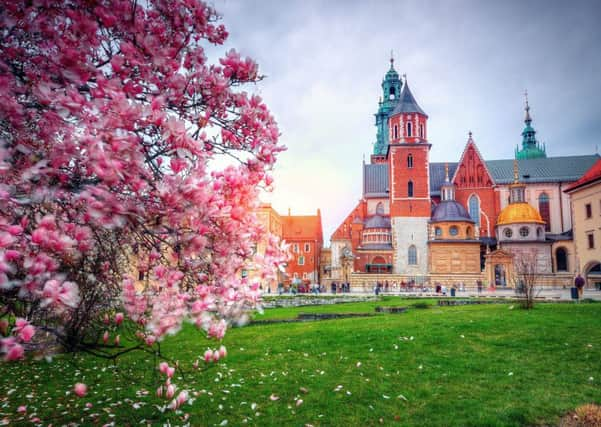Travel review: Why Krakow is buzzing with life and history


The party is in full swing as we walk into Plac Nowy (New Square) in the centre of Kazimierz, a little after 10pm on a hot August Saturday. Tables and chairs from cafes and bars that surround the scruffy but buzzing market area spill onto the pavements.
Almost all of them are occupied by tourists, including groups of lairy “nurses” and “convicts”, who look determined to drink the city dry as they shout their way from one drinking hole to the next.
Advertisement
Hide AdAdvertisement
Hide AdKrakow, the second largest and one of the oldest cities in Poland, plays host to 10 million visitors a year – and most of them head for the city’s Main Square or the rejuvenated Jewish quarter, Kazimierz.
But these busy old streets were not always a place of such merriment. Krakow’s Jewish community thrived here for more than 500 years and, by the beginning of the Second World War, had swelled to some 68,000 people, about a quarter of the city’s population.
Some 52,000 were forcibly deported after the Nazis took power, suffering atrocities in the nearby Plaszow labour camp (the setting for Steven Spielberg’s epic Schindler’s List) and the Auschwitz-Birkenau and Belzec death camps.
After the war, Kazimierz was largely abandoned, but since 1989, when democracy returned to the country, Polish Jews have been free to reclaim confiscated buildings. Low property prices encouraged entrepreneurs to invest, and students looking for cheap accommodation followed, making their homes among the synagogues and packed cemeteries.
Advertisement
Hide AdAdvertisement
Hide AdThe ensuing years have seen a remarkable turnaround – the area is now home to a jumble of tiny galleries, quirky shops, vintage clothing shops and bars and restaurants to suit every taste and wallet.
Where to stay...
Vienna House Andel’s Hotel: One of the nicest and handiest hotels is this four-star property, a short walk from Krakow’s Main Square (Rynek Glowny). Built in 2007, it has 159 rooms – all big, beautiful and extremely comfortable. The everything-you-could-possibly-think-of breakfasts are a big hit. Rooms cost from £72 per night. Visit viennahouse.com
Where to eat...
Kogel Mogel Restaurant: This traditional restaurant near the Main Square runs a hands-on lesson in how to make pierogi (Polish dumplings). There’s also the opportunity to sample a variety made properly and boiled to perfection. Try them stuffed with potatoes and onion, stuffed with minced veal and served with mushroom sauce, and stuffed with stewed sauerkraut and mushrooms. Dumplings workshops cost £52 per group (minimum seven people). Pierogi dishes from £6-£8pp. Visit kogel-mogel.pl/en
Mavericks Restaurant, Vienna House Andel’s Hotel: Chef Marcin Socha and his staff serve up a deliciously eclectic Californian tasting/sharing menu with various Asian, Mexican and European influences, at this brightly coloured restaurant. Fine Californian wines match the food perfectly. A six-course tasting menu for four costs about £18pp. Visit viennahouse.com
Where to drink...
Advertisement
Hide AdAdvertisement
Hide AdPijalnia Wodki I Piwa (Vodka and Beer Bar), Old Town: At this no-frills bar, you can eat, drink and become very merry on a modest budget. Three pints of good local beer, a small red wine and three shots of lemon vodka costs less than a tenner. Snacks at less than £2 include beef tartare (served with a raw egg), herring in oil, white borscht (classic Polish soup) and a selection of toasties. Visit pwip.com.pl
What to do...
Krakow Old Town: The Unesco World Heritage site is home to the city’s Main Square, the biggest medieval town square in Europe, which hosts dozens of festivals every year, including Krakow’s famous Christmas Market. In the middle of the square is the magnificent Cloth Hall, home to upmarket craft stalls, cafes and a museum.
Auschwitz: The former Polish military barracks is in Oswiecim, about 40 miles to the west of Krakow. In 1941, a much bigger camp, Auschwitz II-Birkenau, was built less than two miles away. Up to 1.5 million people are believed to have died at Auschwitz-Birkenau. Visitors are advised to book a full-day tour with an agency which will arrange transport and a guide. Visit auschwitz.org/en
Wieliczka Salt Mine: Built on nine levels, this 700-year-old mine, a 30-minute drive south-east of Krakow, stretches for more than 180 miles and reaches a depth of almost 1,000ft. The three-hour underground visit includes about two miles of walking, hundreds of steps, and a peek at more than 20 chambers, all hand-hewn from the glistening rock salt. Admission and guided tours from £18.50. Visit wieliczka-saltmine.com
GETTING THERE
Advertisement
Hide AdAdvertisement
Hide AdWizzair (wizzair.com) flies to Katowice from Bristol, Doncaster-Sheffield, Glasgow and Luton from £17.99 (one way). Wizzair operates 80 routes from nine UK airports. The bus journey from Katowice Airport to Krakow takes about two hours and costs about £11pp (one way). For more information on the destination, see poland.travel/en and visitkrakow.com